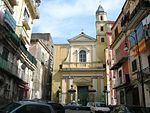Castellammare Cathedral
16th-century Roman Catholic church buildings in ItalyCathedrals in CampaniaRoman Catholic cathedrals in ItalyRoman Catholic churches completed in 1893Roman Catholic churches in Castellammare di Stabia

The Co-Cathedral of Saint Mary of the Assumption and Saint Catellus (Italian: Concattedral di Maria Santissima Assunta e San Catello) is the Roman Catholic duomo or cathedral of Castellammare di Stabia in the metropolitan city of Naples, in the region of Campania, Italy. It is the main church in Castellammare di Stabia and it is co-cathedral of the Archdiocese of Sorrento-Castellammare. It was built in 1587 and was consecrated in 1893. Inside on display for worship is the statue of Saint Catello, the patron saint of the city.
Excerpt from the Wikipedia article Castellammare Cathedral (License: CC BY-SA 3.0, Authors, Images).Castellammare Cathedral
Via Vincenzo Maria Sarnelli,
Geographical coordinates (GPS) Address Nearby Places Show on map
Geographical coordinates (GPS)
| Latitude | Longitude |
|---|---|
| N 40.694861111111 ° | E 14.480416666667 ° |
Address
Via Vincenzo Maria Sarnelli
Via Vincenzo Maria Sarnelli
80053
Campania, Italy
Open on Google Maps








